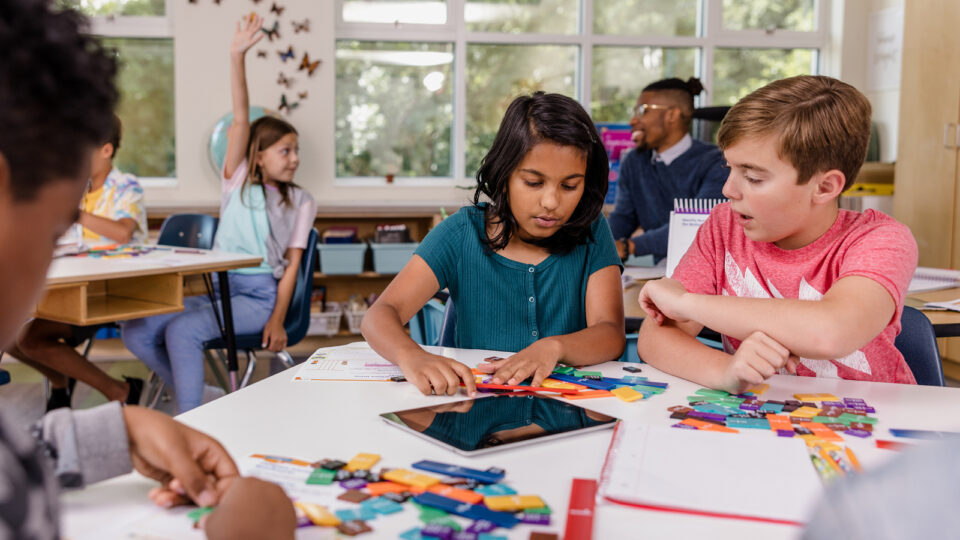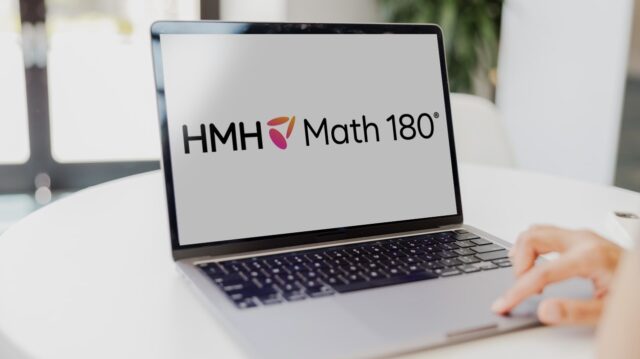
Let’s start with a problem that involves division and fractions—making it instantly groan-worthy in classrooms everywhere:
\[\text{Divide }3\div\frac{1}{2}\text{.}\]
Many students would solve it by rewriting 3 as \(\frac{3}{1}\) then multiplying by the reciprocal of \(\frac{1}{2}\). This procedure arrives at a solution quickly enough, but in my opinion, it also creates more questions than answers.
- Why is 3 the same as \(\frac{3}{1}\)?
- Why can division be thought of as multiplication by the reciprocal?
- How would you complete this process if the divisor weren’t a fraction?
Astute students may even take a step back and question the very foundation:
- Why is knowing how to divide by fractions necessary?
How many students—or adults for that matter—understand fundamentally that dividing by a fraction less than one will make a number bigger? In a perfect world, math class isn’t about solving problems to get the “right” answer, but instead it’s about students discussing problems and engaging with how to solve them using mathematical thinking.
We do not live in a perfect world of course, but all classrooms ideally have some element of discourse so that students are forming and discussing ideas, not just finding answers to questions. Even the standard process for dividing fractions can be taught in a way that has students wrestling with basic concepts about numbers and arithmetic.
What Is Mathematical Discourse?
The definition of mathematical discourse is the communication that occurs in a math classroom. It broadly refers to both teacher-to-student discussion and student-to-student discussion, though it is student-to-student discussion that is most important and at the heart of this article. Discourse in mathematics is sometimes referred to using a different name, such as math conversations or math talk.
When facilitated well, mathematical discourse affirms students’ different approaches to problem solving and “calls for the development of students’ shared understanding of mathematical ideas by analyzing and comparing student approaches and arguments” (Smith & Stein, 2011). Effective discourse happens when students not only explain their own mathematical ideas clearly but also listen carefully to their peers’ ideas.
Why Is Discourse Important in Math?
In 2014, the National Council of Teachers of Mathematics, or NCTM, published Principles to Actions: Ensuring Mathematical Success for All, a landmark publication that connected mathematical standards to instructional actions. In it, NCTM identifies eight key math teaching practices, one of which is “facilitate meaningful mathematical discourse.” Principles to Actions explains how mathematical discourse is “central to meaningful learning of mathematics,” where students are active members of a mathematics community who can both explain what they’re thinking and respond to others’ ideas.
The importance of discourse in math extends beyond classroom walls and benefits both students and teachers:
- The teacher learns the content more deeply and better learns how to teach it (Sherin, 2002).
- Students learn to think like mathematicians (Jang, 2010).
- Students learn mathematics at a deeper level (Clark et al., 2012).
- Students improve their ability to communicate orally and understand their own thought processes (Huggins & Maiste, 1999).
Discourse helps students to articulate their thinking and compare mathematical ideas with other students. They are formulating ideas, testing them out, and applying different procedures to problems. In this way, students are deepening their conceptual understanding and building procedural fluency even without applying pencil to paper.
The discipline of mathematics is deep and touches on many aspects of critical thinking, such as tackling questions without clear answers, listening carefully, and communicating orally. When math class is seen as a place where confusion can be voiced and disagreements can be examined, students ultimately learn math more deeply and grow socially, emotionally, and academically.
Rough-Draft Talk
The reality is that math discourse is not easy to nurture. Simply talking in the math classroom is not the same thing as engaging in meaningful math talk. Even on-topic discussion can involve only surface-level math that lacks critical analysis and falls short of developing a shared understanding.
Personally, I like Judit Moschkovich’s (2003) characterization of mathematical discourse in terms of “register,” where a mathematics register incorporates the “meanings, styles, and modes of argument” that make mathematical arguments so precise and logical. Contrast these two examples of students explaining how to divide 3 ÷ \(\frac{1}{2}\):
- High Mathematical Register: I can tell there are 2 groups of \(\frac{1}{2}\) for every 1 whole, so to divide 3 by \(\frac{1}{2}\), I think about it as 2 groups times 3 wholes, or 6 groups in total.
- Low Mathematical Register: I have to divide 3 by \(\frac{1}{2}\). I have 3, so 3 something, maybe 3 things. There are equal groups of \(\frac{1}{2}\), and so to make equal groups, I have 3 things, and then \(\frac{1}{2}\) of the things makes 2 of the 3 things. So there are 6 things total, meaning 3 divide by \(\frac{1}{2}\) is 6.
Both of those responses reflect students who are staying on topic and offering solutions that are ripe for discussion. They both even go deeper than the standard process of writing 3 as \(\frac{3}{1}\) then multiplying by the reciprocal. But when you examine the register, the first response is precise, brief, and logically coherent. The second response is less precise and requires more interpretation and can be considered “rough-draft talk” (Jansen et al., 2016). While teachers should model and encourage a more mathematical register, rough-draft talk can still be valuable in thinking through math problems and engaging in discourse.
Amanda Jansen and colleagues explain: “Explicit promotion of rough-draft talk takes productive classroom discourse to a higher level because it provides a safe space for students to develop understanding.” That is, teachers can affirm students’ thought processes and value effortful thinking even if the language is messy or the solution not yet correct. Learning math is no different from any other subject in the sense that it requires ideas being revised over time and rewards students willing to test out new ideas with their peers.
The Four Levels of Discourse in Math
When there is a learning community, minimally including a teacher and a group of students, the community can be thought of as having levels of mathematical discourse, a framework proposed and studied by Kimberly Hufferd-Ackles, Karen Fuson, and Miriam Gamoran Sherin (2004). The framework examines four aspects of that community:
- Who does the questioning?
- How do students explain their mathematical thinking?
- What are the sources of students’ mathematical ideas?
- Who is responsible for students’ learning?
At the lowest level of math discourse (level 0), the teacher is the questioner, and students are expected to provide brief responses throughout whole-class discussion. At the highest level (level 3), students listen and engage actively, ultimately learning from one another.
Level 0Teacher-directed classroom with brief student responses |
As a math learning community starts to become one centered around discourse, there is a “shift from teacher as questioner to students and teacher as questioners.” Students take more responsibility over their learning and increasingly articulate their ideas. At this level, math sense—which can be difficult to evaluate—is an important aspect of evaluation. |
Level 1Teacher-centered classroom with more mathematical thinking |
At this level, “answers” are a relatively small part of math instruction, with the teacher focusing on strategies being used and follow-up questions. Student ideas are raised in discussion, often briefly, but the teacher is still fundamentally the sole questioner. |
Level 2Some co-teaching and co-learning, as students talk with each other |
The teacher is no longer the sole questioner and facilitates an increasing amount of student-to-student talk. Students are starting to become more confident about their ideas and occasionally end up guiding a lesson altogether. They are often tasked with explaining other students’ ideas in their own words. |
Level 3Teacher as a co-teacher and co-learner |
At the highest level, student-to-student discourse in math is no longer dependent on the teacher, who at this point has a more peripheral and monitoring role. Students probe each others’ thinking, causing all students to be precise and thorough when working through problems. Students listen to understand and assist each other in catching and correcting errors. |
Promoting mathematical discourse is a skill in and of itself, and a level 3 classroom will not emerge overnight. Teachers must model what it means to investigate a problem critically; after all, they are able to communicate with mathematical precision better than their students. Over time their role doesn’t go away; it transforms. Mitchell Nathan and Eric Knuth (2003) explain how over time, teachers “learn the stepping in and out that is paramount to promoting productive discourse.”
How to Implement Mathematical Discourse in the Classroom
Although discourse is a critical part of a successful mathematics classroom, it asks a lot of the educators who implement it. Teachers must honor and build on student thinking while ensuring that the mathematical ideas of a lesson remain a consistent part of the discussion (Engle & Conant, 2002). Tim Kanold, an author for HMH Into Math, breaks down student discourse into two types:
- Whole-group discourse: The teacher leads the discussions, doing most of the speaking. Conversations are primarily teacher-to-student, not student-to-student.
- Small-group discourse: The teacher facilitates a discussion, physically leaving the front of the room, observing what students are doing and providing meaningful feedback.
While some amount of whole-group discourse is required, it is small-group discourse where magic happens. It is easier to embrace mistakes and explore curiosity when speaking to peers. Kanold explains that, ideally, teachers are touring a classroom, critically listening to student interactions, and have “prepared prompts that can scaffold down an entry point into the mathematical task presented” for students who are stuck.
These “prepared prompts,” or math talk moves, are flexible ways to focus a discussion and keep students engaged. These can be useful as mathematical discourse strategies for the teacher to try. Here are some common tactics for delivering these prompts:
- Revoicing: The teacher repeats all or part of what a student says and asks whether the idea was stated correctly.
- Repeating: Students restate someone else’s reasoning, but in their own words.
- Reasoning (Why Do You Think That?): After a student responds to a question, the teacher immediately follows with “Why do you think that?” to press for reasoning.
- Adding On: The teacher poses one or more questions that are open-ended and contribute one step towards a more complex explanation.
- Critique, Correct, and Clarify: The teacher presents a partial or broken explanation or solution method, and then students must identify the error(s) or ambiguity.

Math Discourse and Technology
In some ways, mathematical discourse seems almost opposite to technology. After all, students can talk about math without a computer in sight! However, technology—especially math technology, or digital tools specific to math class—can serve as a powerful reference for facilitating discourse:
- Discussion Fodder: Digital manipulatives are a flexible way to model math and provide fodder for discussion. Students can differ on what the manipulatives represent and how they can be used to solve a problem, and the teacher can explore ideas in real-time by manipulating the models.
- Student Interaction: Some digital tools let teachers poll or otherwise interact in real time with students. These activities can reveal misconceptions and class-wide trends, providing plenty of discussion fodder.
- Accessibility Support: Technology can provide access, helping to ensure that all students have ideas to discuss. Text-to-speech technology can support students with vision impairment, and speech-to-text technology can support students with auditory impairment. Images, graphs, and diagrams shown on a digital screen can be enlarged, and audio and video components can be slowed down.
The technology can also be the platform on which discourse happens. Discussion can happen online synchronously through meeting software or asynchronously in environments like discussion forums and wiki pages. In fact, some students may thrive in if not require an environment where discussions can happen virtually.
Math Discourse Examples
In the article “Math Talk: Making the Most of Math Class Discussions,” author Jennifer Lenhardt walks through different examples of what math discourse can look like, with the teacher asking questions that involve students in different ways. Math discourse can achieve a variety of goals:
- Redirect discussions into smaller groupings to involve more voices, for example by having students turn and talk to a partner in response to a prompt.
- Gather formative assessment data, for example by having students discuss a problem in pairs or small groups as the teacher circulates around the room to identify common themes and areas of confusion.
- Support active listening, for example by asking a student to share something that a classmate recently said.
- Unlock student ideas and provide equitable access into a discussion, for example by starting class with a warm-up that does not require much mathematical background.
- Bridge from a non-mathematical context to a mathematical one, for example by transitioning a problem schema such as “is this always, sometimes, or never true” from a general opinion (“the book is better than the movie”) to a mathematical statement (“2x < 3x”).
- Extend student thinking, for example by asking prompts with difficult or nuanced mathematical answers (“Can we think of any value for x that would make this not true?”).
With all of these goals in mind, math discourse sounds different in every classroom and must be tailored to the specific students who are learning. One way to think about promoting good discourse in the math classroom is by thinking about what makes a good question, which can come in many forms:
- Literal questions that ask what students are doing and thinking: “How did you know to multiply 2 groups by 3 wholes?”
- Questions that scaffold instruction and support student thinking: “How can you rewrite a whole number as a fraction?”
- Questions that ask students to hypothesize or generalize: “How would your solution change if you replace the denominator of \(\frac{1}{2}\) with another number?”
Conclusion: Discourse in the Math Classroom
Learning math requires trying out ideas, questioning assumptions, looking for counterarguments, and restating ideas more precisely. There are many ways to navigate and facilitate a discussion, in terms of the language that students use, the involvement of the teacher, how technology is involved, and what questions are being asked. But there is no getting around the basic fact that discussion is needed for students to truly engage with the mathematical ideas being taught. One cannot learn math without discussing math!
***
HMH Into Math for Grades K–8 is a core math curriculum that includes whole-group, small-group, and partner work and encourages mathematical discourse.
Works Cited
Clark, F., Cochran, R., Dominick, A., Fulmore, J., Mayer, J., & Parrish, S. (2012). Challenging Courses and Curricula: A Model for All Students (Greater Birmingham Mathematics Partnership Phase II Research) [Working Paper]. http://www2.math.uab.edu/GBMP/Challenging%20Courses%20and%20Curricula%20article%20FEB%202012%20BM.pdf
Engle, R. A., & Conant, F. R. (2002). Guiding Principles for Fostering Productive Disciplinary Engagement: Explaining an Emergent Argument in a Community of Learners Classroom. Cognition and Instruction, 20(4), 399–483.
Hufferd-Ackles, K., Fuson, K. C., & Sherin, M. G. (2004). Describing Levels and Components of a Math-Talk Learning Community. Journal for Research in Mathematics Education, 35(2), 81–116. https://doi.org/10.2307/30034933
Huggins, B., & Maiste, T. (1999). Communication in Mathematics [Research Report]. Saint Xavier University & IRI/Skylight.
Jang, H. (2010). Measuring Teacher Beliefs about Mathematics Discourse: An Item Response Theory Approach [Doctor of Philosophy]. University of California, Berkeley.
Jansen, A., Cooper, B., Vascellaro, S., & Wandless, P. (2016). Rough-Draft Talk in Mathematics Classrooms. Mathematics Teaching in the Middle School, 22(5), 304–307. https://doi.org/10.5951/mathteacmiddscho.22.5.0304
Moschkovich, J. (2003, July 13). What Counts as Mathematical Discourse? International Group for the Psychology of Mathematics Education. 27th International Group for the Psychology of Mathematics Education Conference Held Jointly with the 25th PME-NA Conference, Honolulu, HI.
Nathan, M. J., & Knuth, E. J. (2003). A Study of Whole Classroom Mathematical Discourse and Teacher Change. Cognition and Instruction, 21(2), 175–207.
Sherin, M. G. (2002). A Balancing Act: Developing a Discourse Community in a Mathematics Classroom. Journal of Mathematics Teacher Education, 5(3), 205–233.
Smith, M. S., & Stein, M. K. (2018). 5 Practices for Orchestrating Productive Mathematical Discussion (Second Edition). National Council of Teachers of Mathematics.
Be the first to read the latest from Shaped.
Get our FREE guide “Optimizing the Math Classroom: 6 Best Practices.”












